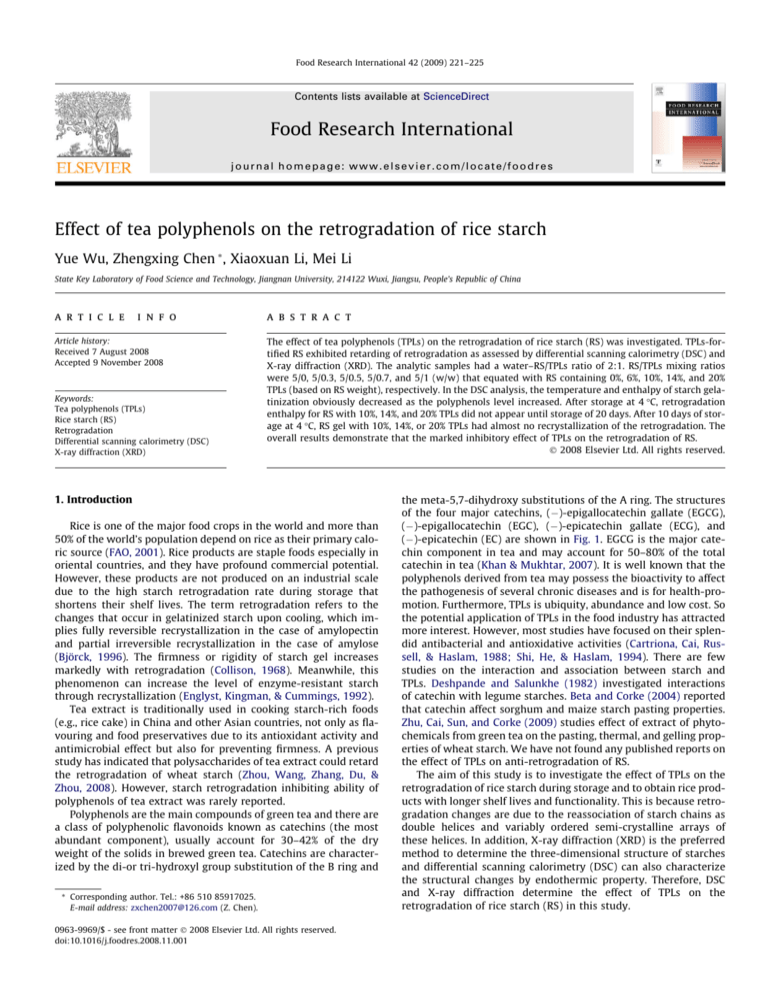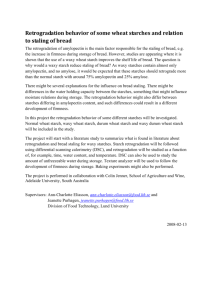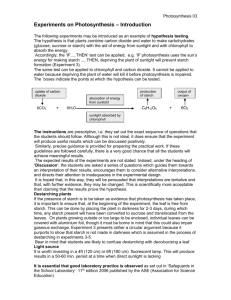
Food Research International 42 (2009) 221–225
Contents lists available at ScienceDirect
Food Research International
journal homepage: www.elsevier.com/locate/foodres
Effect of tea polyphenols on the retrogradation of rice starch
Yue Wu, Zhengxing Chen *, Xiaoxuan Li, Mei Li
State Key Laboratory of Food Science and Technology, Jiangnan University, 214122 Wuxi, Jiangsu, People’s Republic of China
a r t i c l e
i n f o
Article history:
Received 7 August 2008
Accepted 9 November 2008
Keywords:
Tea polyphenols (TPLs)
Rice starch (RS)
Retrogradation
Differential scanning calorimetry (DSC)
X-ray diffraction (XRD)
a b s t r a c t
The effect of tea polyphenols (TPLs) on the retrogradation of rice starch (RS) was investigated. TPLs-fortified RS exhibited retarding of retrogradation as assessed by differential scanning calorimetry (DSC) and
X-ray diffraction (XRD). The analytic samples had a water–RS/TPLs ratio of 2:1. RS/TPLs mixing ratios
were 5/0, 5/0.3, 5/0.5, 5/0.7, and 5/1 (w/w) that equated with RS containing 0%, 6%, 10%, 14%, and 20%
TPLs (based on RS weight), respectively. In the DSC analysis, the temperature and enthalpy of starch gelatinization obviously decreased as the polyphenols level increased. After storage at 4 °C, retrogradation
enthalpy for RS with 10%, 14%, and 20% TPLs did not appear until storage of 20 days. After 10 days of storage at 4 °C, RS gel with 10%, 14%, or 20% TPLs had almost no recrystallization of the retrogradation. The
overall results demonstrate that the marked inhibitory effect of TPLs on the retrogradation of RS.
Ó 2008 Elsevier Ltd. All rights reserved.
1. Introduction
Rice is one of the major food crops in the world and more than
50% of the world’s population depend on rice as their primary caloric source (FAO, 2001). Rice products are staple foods especially in
oriental countries, and they have profound commercial potential.
However, these products are not produced on an industrial scale
due to the high starch retrogradation rate during storage that
shortens their shelf lives. The term retrogradation refers to the
changes that occur in gelatinized starch upon cooling, which implies fully reversible recrystallization in the case of amylopectin
and partial irreversible recrystallization in the case of amylose
(Björck, 1996). The firmness or rigidity of starch gel increases
markedly with retrogradation (Collison, 1968). Meanwhile, this
phenomenon can increase the level of enzyme-resistant starch
through recrystallization (Englyst, Kingman, & Cummings, 1992).
Tea extract is traditionally used in cooking starch-rich foods
(e.g., rice cake) in China and other Asian countries, not only as flavouring and food preservatives due to its antioxidant activity and
antimicrobial effect but also for preventing firmness. A previous
study has indicated that polysaccharides of tea extract could retard
the retrogradation of wheat starch (Zhou, Wang, Zhang, Du, &
Zhou, 2008). However, starch retrogradation inhibiting ability of
polyphenols of tea extract was rarely reported.
Polyphenols are the main compounds of green tea and there are
a class of polyphenolic flavonoids known as catechins (the most
abundant component), usually account for 30–42% of the dry
weight of the solids in brewed green tea. Catechins are characterized by the di-or tri-hydroxyl group substitution of the B ring and
* Corresponding author. Tel.: +86 510 85917025.
E-mail address: zxchen2007@126.com (Z. Chen).
0963-9969/$ - see front matter Ó 2008 Elsevier Ltd. All rights reserved.
doi:10.1016/j.foodres.2008.11.001
the meta-5,7-dihydroxy substitutions of the A ring. The structures
of the four major catechins, ( )-epigallocatechin gallate (EGCG),
( )-epigallocatechin (EGC), ( )-epicatechin gallate (ECG), and
( )-epicatechin (EC) are shown in Fig. 1. EGCG is the major catechin component in tea and may account for 50–80% of the total
catechin in tea (Khan & Mukhtar, 2007). It is well known that the
polyphenols derived from tea may possess the bioactivity to affect
the pathogenesis of several chronic diseases and is for health-promotion. Furthermore, TPLs is ubiquity, abundance and low cost. So
the potential application of TPLs in the food industry has attracted
more interest. However, most studies have focused on their splendid antibacterial and antioxidative activities (Cartriona, Cai, Russell, & Haslam, 1988; Shi, He, & Haslam, 1994). There are few
studies on the interaction and association between starch and
TPLs. Deshpande and Salunkhe (1982) investigated interactions
of catechin with legume starches. Beta and Corke (2004) reported
that catechin affect sorghum and maize starch pasting properties.
Zhu, Cai, Sun, and Corke (2009) studies effect of extract of phytochemicals from green tea on the pasting, thermal, and gelling properties of wheat starch. We have not found any published reports on
the effect of TPLs on anti-retrogradation of RS.
The aim of this study is to investigate the effect of TPLs on the
retrogradation of rice starch during storage and to obtain rice products with longer shelf lives and functionality. This is because retrogradation changes are due to the reassociation of starch chains as
double helices and variably ordered semi-crystalline arrays of
these helices. In addition, X-ray diffraction (XRD) is the preferred
method to determine the three-dimensional structure of starches
and differential scanning calorimetry (DSC) can also characterize
the structural changes by endothermic property. Therefore, DSC
and X-ray diffraction determine the effect of TPLs on the
retrogradation of rice starch (RS) in this study.
222
Y. Wu et al. / Food Research International 42 (2009) 221–225
Fig. 1. Structures of the major tea polyphenols (Khan & Mukhtar, 2007).
2. Materials and methods
2.3. X-ray diffraction
2.1. Materials
The samples as same as DSC analysis were RS with 0%, 6%, 10%,
14%, or 20% TPLs and adding double deionized water and gelatinized by steam heating for 20 min in the closed thermostat water
bath. These samples were cooled to room temperature then stored
at 4 °C condition for 10 days. The freeze-dried samples were
ground and then powder samples passed through a 100 mesh sieve
before testing. The recrystallization analysis was carried out using
a Bruker D8 Advance speed X-ray diffractometer (Bruker AXS,
Rheinfelden, Germany) equipped with a copper tube operating at
40 kV and 200 mA, producing CuKa radiation of 0.154 nm wavelength. Diffractograms were obtained by scanning from 4° (2h) to
40° (2h) at a rate of 4°/min, a step size of 0.02°, a divergence slit
width (DS) of 1°, a receiving slit width (RS) of 0.02 mm, and a scatter slit width (SS) of 1°. Each sample was measured once. MDI Jade
5.0 was used to analyze the diffractograms.
Rice starch was purchased from Sigma Co. (St. Louis, MO, USA).
The contents of moisture, ash, and protein in this rice starch are
11.6%, 0.14%, and 0.55% (data from Sigma Co.), respectively, while
the amylose content is 21% (Gunaratne & Hoover, 2000). TPLs
(TGP-95B) were obtained from Taiyo Green Power Co. Ltd. (Wu
Xi, China) with total polyphenols of 97%, contain of 50% EGCG,
20% ECG, 18% EGC, and 7% EC, analyzed by high-pressure liquid
chromatography.
2.2. Differential scanning calorimetry (DSC)
The DSC measurements were carried out using 61 DSC-Pyris
Diamond (Perkin–Elmer Corp., Norwalk, CT, USA). The gelatinization and retrogradation properties of the samples were determined
from the DSC curves. The mixing ratios of RS/TPLs were 5/0, 5/0.3,
5/0.5, 5/0.7, and 5/1 (w/w) that equated with RS containing 0%, 6%,
10%, 14%, and 20% TPLs (based on RS weight), respectively. The calorimeter was calibrated with an indium standard. Samples of the
mixtures (about 1 mg) were accurately weighed into aluminum
DSC pans, and deionized water was added by micropipette in order
to achieve a water-sample ratio of 2:1. The sample pans were
sealed and equilibrated at room temperature for 24 h before analysis. The samples were heated at a rate of 10 °C/min in a temperature range of 10–85 °C using an empty pan as reference. The onset
temperature To, peak temperature Tp, and conclusion temperature
Tc were, respectively, determined from the first run heating DSC
curves. Gelatinization enthalpy (DHg) was evaluated based on the
area of the main endothermic peak. Then the gelatinized samples
were stored at 4 °C for 5, 10, and 20 days. For retrogradation
studies, these stored samples were anew scanned under the same
conditions and the retrogradation enthalpy (DHr) was determined
from the second run heating. In addition, the percentage of
retrogradation (R%) was calculated as the ratio of the retrogradation enthalpy to the gelatinization enthalpy in run heating
(Rodríguez-Sandovala, Fernández-Quinterob, Cuvelierc, Relkinc, &
Bello-Pérezd, 2008). Analyses were performed in triplicate.
2.4. Statistical analysis
The mean, standard deviations, and significant differences of
the data collected were calculated and reported using SAS version
8 (SAS Institute Inc., 2000); differences were considered significant
at p < 0.05. The data reported in all the tables were the average of
triplicate observations unless otherwise indicated.
3. Results and discussion
3.1. Thermal analysis
Adding TPLs considerably affected the gelatinization properties
of RS. Fig. 2 shows the effect of varying the concentration of TPLs
on the gelatinization of RS. There was a clear shift in the endotherms toward a lower temperature and decreasing enthalpy with
the content of the TPLs increasing. The temperatures and enthalpy
values associated with gelatinization are presented in Table 1. During the first endothermic transition, compared with RS (the control), RS with 20% TPLs clearly facilitated the gelatinization of RS
with earlier onset of To, Tp and Tc (10.93, 6.53, and 4.7 °C, respectively) and a lower enthalpy of melting by 2.57 J/g.
223
Heat Flow Endo Up (mW)
Y. Wu et al. / Food Research International 42 (2009) 221–225
a
b
c
d
e
56
60
65
70
Temperature (ºC)
75
80
83
Fig. 2. Gelatinization thermograms of rice starch containing various ratios tea
polyphenols: 0% (based on rice starch weight) TPLs (a); 6% TPLs (b); 10% TPLs (c);
14% TPLs (d); and 20% TPLs (e).
TPLs gave a clear effect on the gelatinization enthalpy that was
to disrupt the crystallites. This suggested that the TPLs polyhydric
structure might be responsible for the differences in gelatinization.
It may be that the hydrophilic character of TPLs OH groups might
interact with side chains of amylopectin and bind to the amorphous region of starch granules to various degrees and thus change
the coupling forces between the crystallites and the amorphous
matrix. The result is that facilitate the easy hydration of starch
granules, requiring less thermal energy for gelatinization (Zhu
et al., 2009).
The retrogradation peak in the second run heating DSC curves
shifted to a lower temperature than the gelatinization peak in
the first run heating DSC curve and was present at around 52 °C
(data not shown). The enthalpy values of the retrograded starch reflect the melting of the crystallites formed by the association between adjacent double helices during gel storage (Hoover &
Senanayake, 1996), and this endotherm peak was due to the melting of retrograded amylopectin (Abd, Norziah, & Seow, 2000; Fearn
& Russell, 1982) rather than amylose. Table 2 lists the changes in
retrogradation enthalpy and retrogradation ratio (DHr/DHg) of gel-
atinized RS with difference concentrations of TPLs as a function of
storage time. In the absence of TPLs, DHr and R% of gelatinized RS
significantly increased with storage time to 8.501 J/g and 71.3%
after 20 days. However, the effect of TPLs on preventing the retrogradation could be clearly seen when it was added to RS. The RS
with 10%, 14%, and 20% TPLs systems did not show retrogradation
endotherm on the DSC after 10 days of storage. Twenty days after
the DSC test, it was also clearly shown that DHr and R% decreased
from 8.501 to 0.550 J/g and 71.3% to 5.9% with 20% TPLs levels adding. Some researchers (Beta & Corke, 2004) added catechin (up to
100 mg) to maize or sorghum starch (3 g, 14% mb) in suspensions
containing 10.32% dry solid content. The catechin decreased setback viscosity of the two starches. In Rapid Visco Analyser (RVA)
analysis, the setback value (final viscosity–hot paste viscosity) is
reflecting the degree of retrogradation of a starch paste. This value
is lower that indicates retrogradation occurs to a lesser extent
(Varavinit, Shobsngob, & Warunee, 2003). Since the initial gel network development is dominated by amylose gelation, setback is
more likely related to the retrogradation tendency of amylose
(Abd et al., 2000). In addition, gelatinized wheat starch stored for
48 h and went through ageing, the phytochemical extracts of green
tea (mainly phenolic compounds) considerably reduced the gel
hardness (Zhu et al., 2009). These results suggest that the TPLs
could significantly inhibit the retrogradation of amylose and amylopectin of starch.
Retrograded starch forms a strong hydrogen bond between the
molecules and completes a cement structure in amorphous regions.
The interactions of starch with phenolics include associations that
are formation of hydrogen bridges through the hydroxyl groups
(Belitz & Grosch, 1999). It is notable that TPLs contain highly reactive OH groups, so it may explain the interaction of these groups
with the OH groups of RS to form a hydrogen bond that interfered
with the alignment of starch polymer chains (Beta & Corke, 2004).
Researchers ever considered the effect of the size and number of
OH groups of the additives on the retrogradation of starch (Smits,
Kruiskamp, van Soest, & Vliegenthart, 2003), but we think the reactivity of OH groups is more important, so that they could compete
to form hydrogen bond with starch molecules themselves.
Table 1
Gelatinization temperatures and enthalpy of rice starch/tea polyphenols mixtures at various ratios.
Samples
To (°C)
A
Tp (°C)
a
70.30 ± 0.10
66.06 ± 0.51b
63.73 ± 0.29c
61.97 ± 0.65d
59.37 ± 0.62e
RS + 0% TPLs
RS + 6% TPLs
RS + 10% TPLs
RS + 14% TPLs
RS + 20% TPLs
Tc (°C)
a
75.8 ± 0.02
73.43 ± 0.16b
72.25 ± 0.28c
71.05 ± 0.20d
69.27 ± 0.08e
DHg (J/g dry starch)
a
11.92 ± 0.08a
11.99 ± 0.29a
10.92 ± 0.60b
10.49 ± 0.24c
9.35 ± 0.22d
80.3 ± 0.09
79.00 ± 0.23a
78.03 ± 0.29b
77.04 ± 0.25c
75.60 ± 0.13d
To, onset temperature; Tp, peak temperature; Tc, conclusion temperature. Values are means ± SD (n = 3). Values followed by the same letter in the same column are not
significantly different (p < 0.05).
A
Based on the weight of RS.
Table 2
Change in retrogradation enthalpy and retrogradation ratio of rice starch/tea polyphenols mixtures after 4 °C storage.
Samples
RS + 0% TPLsC
RS + 6% TPLs
RS + 10% TPLs
RS + 14% TPLs
RS + 20% TPLs
5 days
10 days
20 days
DHr (J/g dry starch)
R%
DHr (J/g dry starch)
R%
DHr (J/g dry starch)
R%
3.635 ± 0.43
n.d.A
n.d.
n.d.
n.d.
30.5
–B
–
–
–
7.618 ± 0.54a
3.69 ± 0.49b
n.d.
n.d.
n.d.
63.9a
30.8b
–
–
–
8.501 ± 0.44a
4.358 ± 0.37b
2.325 ± 0.20c
0.848 ± 0.55d
0.550 ± 0.27d
71.3a
36.3b
21.3c
8.1d
5.9e
Values are means ± SD (n = 3). Values followed by the same letter in the same column are not significantly different (p < 0.05).
A
Not detectable.
B
Not calculated.
C
Based on the weight of RS.
224
Y. Wu et al. / Food Research International 42 (2009) 221–225
25.0
a
SQR(Counts)
20.0
b
c
15.0
with naturally occurring fatty acids and phospholipids of the granule (Zobel, Young, & Rocca, 1988) to produce ‘‘V”-structures (peak
at 20°) (Köksel, Sahbaz, & Özboy, 1993). The peak at 20° is attributed to a well-formed ‘‘V”-structure (Osella et al., 2005). All the diffractograms in Fig. 3 show an obvious peak at approximately 20°,
which could be indicative of the amylose–lipid complex formation.
d
10.0
e
“B” type
5.0
f
“V” type
0
10
15
20
25
30
35
2-Theta(º)
Fig. 3. X-ray diffraction patterns of native rice starch (a) and gelatinized rice starch
gels containing TPLs after 10 days’ storage at 4 °C: 20% (based on rice starch weight)
TPLs (b); 14% TPLs (c); 10% TPLs (d); 6% TPLs (e); and 0% TPLs (f).
However, other researchers (Ma, Yu, & Feng, 2004; Yu, Wang, & Ma,
2005) had confirmed that the retrogradation of thermoplastic
starch was greatly dependent on the hydrogen bond-forming abilities of plasticizers such as urea, formamide, citric acid and glycerol
with starch molecules. The stronger the hydrogen bond between
starch and the plasticizer, the more difficult it is for starch to recrystallize during the storage time.
3.2. Recrystallization
Investigations using XRD were conducted at the same RS and
TPLs concentration as DSC analysis to further and powerfully prove
the preventing effect of TPLs on the retrogradation. Meanwhile,
since most of the recrystallization occurred during the 10 days of
storage, the final recrystallization was investigated by XRD.
The XRD patterns and corresponding crystallinity observed
from RS/TPLs systems are shown in Fig. 3. Native RS showed a typical A-type XRD pattern with strong peaks at 2h close to 14.2,
17.37, 18.7, and 23.37 as observed in previous studies (Arámbula,
González, & Ordorica, 2001; Zobel, 1988). However, once native
RS is gelatinized, it develops a ‘‘B”-type diffraction pattern during
aging (Abd et al., 2000). Retrograded starch gives a ‘‘B-type” diffraction pattern and this is accompanied by gradual increases in
rigidity and phase separation between the polymer and the solvent
(syneresis). B-type crystallinity is characterized by a well-defined
peak at 16.9° (2h). The formation of this peak was the result of
the crystallization of the amorphous starch melt, mainly of the
amylopectin fraction that increased during storage (Osella, Sánchez, Carrara, de la Torre, & Pilar, 2005; Thiré, Simáo, & Andradeb,
2003). As shown in Fig. 3, the intensity of a peak close to 17° of RS
samples with 10%, 14%, and 20% TPLs were nearly nonexistent in a
representative X-ray diffractogram, indicating the disappearance
of the typical B-pattern. This observation agrees with the foregoing
results of the RS with 10%, 14%, and 20% TPLs systems not showing
retrogradation endotherm on the DSC after 10 days of storage. This
implies that TPLs could retard the recrystallization or the retrogradation behavior of gelatinized starch.
Starch retrogradation does not only involve changes in the amylopectin fraction but also in the amylose fraction. Amylose recrystallization is faster and occurs about 1 day after cooling, while
amylopectin recrystallization is slower (Abd et al., 2000) and
mainly responsible for deterioration of starch food such as
firmness.
Lorenz and Kulp (1982) have claimed that amylose chains in
cereal starches form complexes with residual lipids, and this could
hinder the amylose rearrangements. Amylose forms complexes
4. Conclusions
The results of this work demonstrate that the addition of highly
purified TPLs to rice starch could significantly retard retrogradation. Hence, TPLs may be suitable to add to rice products and
simultaneously enhance quality and nutrition. Although this study
only involves one rice starch, the results indicate that the magnitude of these effects is dependent on the amount of TPLs added.
The mechanism that prevents rice starch retrogradation must be
understood at the molecular level, and it must be confirmed
whether this is due to the highly reactive hydroxyl radical of TPLs
acting with rice starch to form hydrogen bond that prevents the
reassociation of starch chains. Moreover, other substances with
highly reactive hydroxyl radical such as vitamin C will be investigated in further studies in order to estimate anti-retrogradation effect of starch. These studies are important for the development of
rice products with longer shelf lives to make them compete more
effectively in the markets.
Acknowledgments
This research work was supported by Grants from the National
11th Five-year Key Project, PCSIRT 0627, and 111 Project B07029.
References
Abd, K. A., Norziah, M. H., & Seow, C. C. (2000). Methods for the study of starch
retrogradation. Food Chemistry, 71, 9–36.
Arámbula, V. G., González, H. J., & Ordorica, F. C. A. (2001). Physicochemical,
structural and textural properties of tortillas from extruded instant corn flour
supplemented with various types of corn lipids. Journal of Cereal Science, 33,
245–252.
Belitz, H. D., & Grosch, W. (1999). Food Chemistry (2nd ed.). Berlin: Springer-Verlag
(pp. 302–304).
Beta, T., & Corke, H. (2004). Effect of ferulic acid and catechin on sorghum and maize
starch pasting properties. Cereal Chemistry, 81, 418–422.
Björck, I. (1996). Starch: Nutritional aspects. In A. C. Eliasson (Ed.), Carbohydrates in
food (pp. 505–553). New York: Marcel Dekker.
Cartriona, M. S., Cai, Y., Russell, M., & Haslam, E. (1988). Polyphenol complexation –
Some thoughts and observations. Phytochemistry, 27, 2397–2409.
Collison, R. (1968). Starch retrogradation. In J. A. Radley (Ed.), Starch and its
derivatives (pp. 198–202). London: Chapman and Hall.
Deshpande, S. S., & Salunkhe, D. K. (1982). Interactions of tannic acid and catechin
with legume starches. Journal of Food Science, 47, 2080–2081.
Englyst, H. N., Kingman, S. M., & Cummings, J. H. (1992). Classification and
measurement of nutritionally important starch fractions. European Journal of
Clinical Nutrition, 46, 33–50.
FAO. (2001). FAO statement on biotechnology. Rome: Food and Agricultural
Organization of the United Nations. <http://www.fao.org>.
Fearn, T., & Russell, P. L. (1982). A kinetic study of bread staling by differential
scanning calorimetry: The effect of specific volume. Journal of the Science of Food
and Agriculture, 33, 537–541.
Gunaratne, A., & Hoover, R. (2000). Effect of heat–moisture treatment of the
structure and physicochemical properties of tuber and root starches.
Carbohydrate Polymers, 49, 425–437.
Hoover, R., & Senanayake, S. P. J. N. (1996). Composition and physicochemical
properties of oat starches. Food Research International, 29, 15–26.
Khan, N., & Mukhtar, H. (2007). Tea polyphenols for health promotion. Life Sciences,
81, 519–533.
Köksel, H., Sahbaz, F., & Özboy, Ö. (1993). Influence of wheat-drying temperatures
on the birefringence and X-ray diffraction patterns of wet-harvested wheat
starch. Cereal Chemistry, 70, 481–483.
Lorenz, K., & Kulp, K. (1982). Cereal and root starch modification by heat–moisture
treatment. Starch/Stäke, 34, 76–81.
Ma, X. F., Yu, J. G., & Feng, J. (2004). Urea and formamide as a mixed plasticizer for
thermoplastic starch. Polymer International, 53, 1780–1785.
Osella, C. A., Sánchez, H. D., Carrara, C. R., de la Torre, M. A., & Pilar, B. M. (2005).
Water redistribution and structural changes of starch during storage of a
gluten-free bread. Starch/Stäke, 57, 208–216.
Y. Wu et al. / Food Research International 42 (2009) 221–225
Rodríguez-Sandovala, E., Fernández-Quinterob, A., Cuvelierc, G., Relkinc, P., & BelloPérezd, L. A. (2008). Starch retrogradation in cassava flour from cooked
parenchyma. Starch/Stäke, 60, 174–180.
Shi, B., He, X. Q., & Haslam, E. (1994). Gelatin–polyphenol interaction. Journal of
American Leather Chemists Association, 89, 98–104.
Smits, A. L. M., Kruiskamp, P. H., van Soest, J. J. G., & Vliegenthart, J. F. G. (2003). The
influence of various small plasticisers and malto-oligosaccharides on the
retrogradation of (partly) gelatinised starch. Carbohydrate Polymers, 51,
417–424.
Thiré, R. M. S. M., Simáo, R. A., & Andradeb, C. T. (2003). High resolution imaging of
the microstructure of maize starch films. Carbohydrate Polymers, 54, 149–158.
Varavinit, S., Shobsngob, S., & Warunee, V. (2003). Effect of amylose content on
gelatinization, retrogradation and pasting properties of different cultivars of
Thai rice. Starch/Stäke, 55, 410–415.
225
Yu, J. G., Wang, N., & Ma, X. F. (2005). The effects of citric acid on the properties
of thermoplastic starch plasticized by glycerol. Starch/Stäke, 57,
494–504.
Zhou, Y. B., Wang, D. F., Zhang, L., Du, C. F., & Zhou, X. L. (2008). Effect of
polysaccharides on gelatinization and retrogradation of wheat starch. Food
Hydrocolloids, 22, 505–512.
Zhu, F., Cai, Y. Z., Sun, M., & Corke, H. (2009). Effect of phytochemical extracts on the
pasting, thermal, and gelling properties of wheat starch. Food Chemistry, 112,
919–923.
Zobel, H. F. (1988). Starch crystal transformations and their industrial importance.
Starch/Stäke, 40, 1–7.
Zobel, H. F., Young, S. N., & Rocca, L. A. (1988). Starch gelatinization: An X-ray study.
Cereal Chemistry, 65, 443–446.









